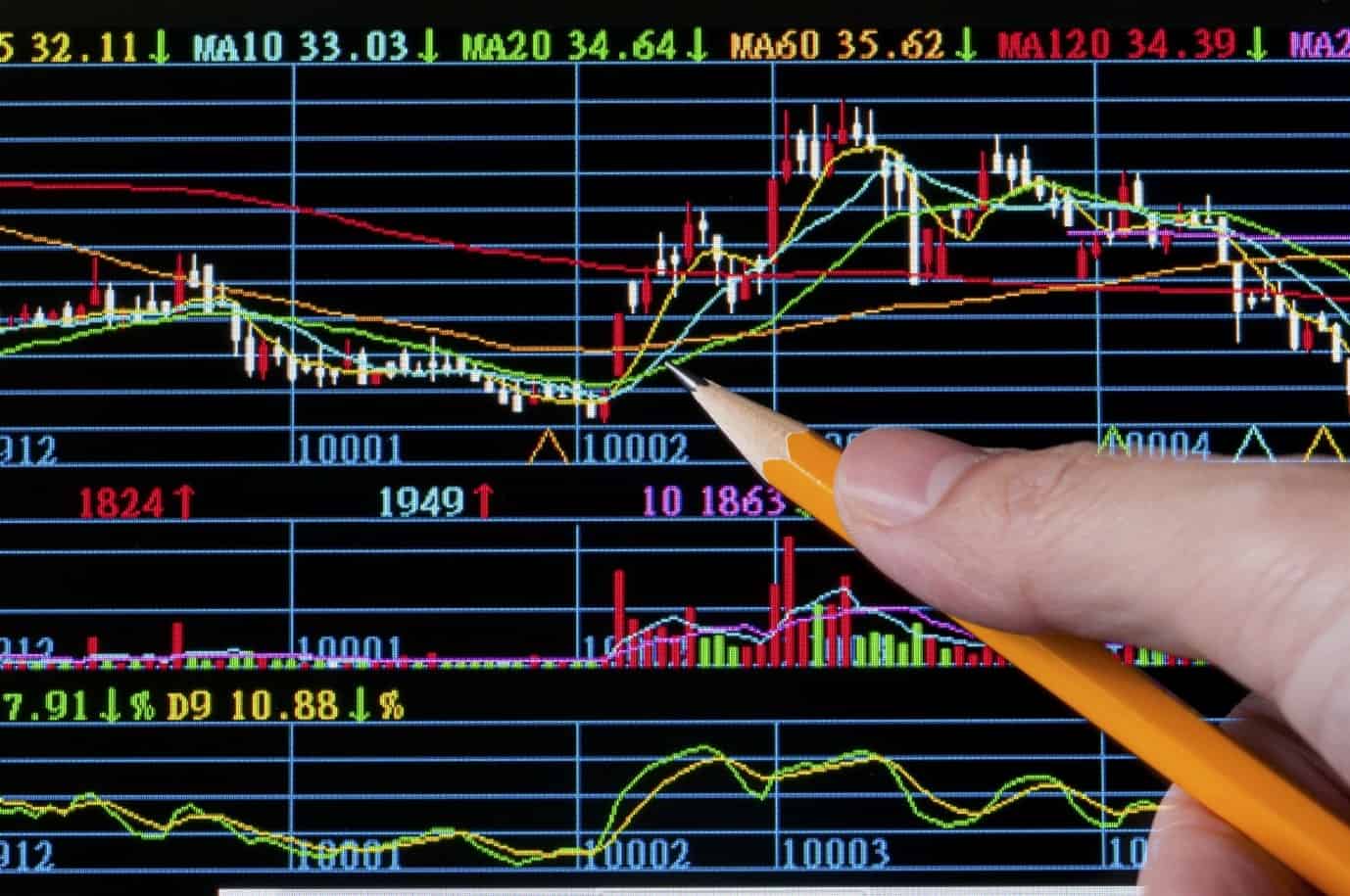
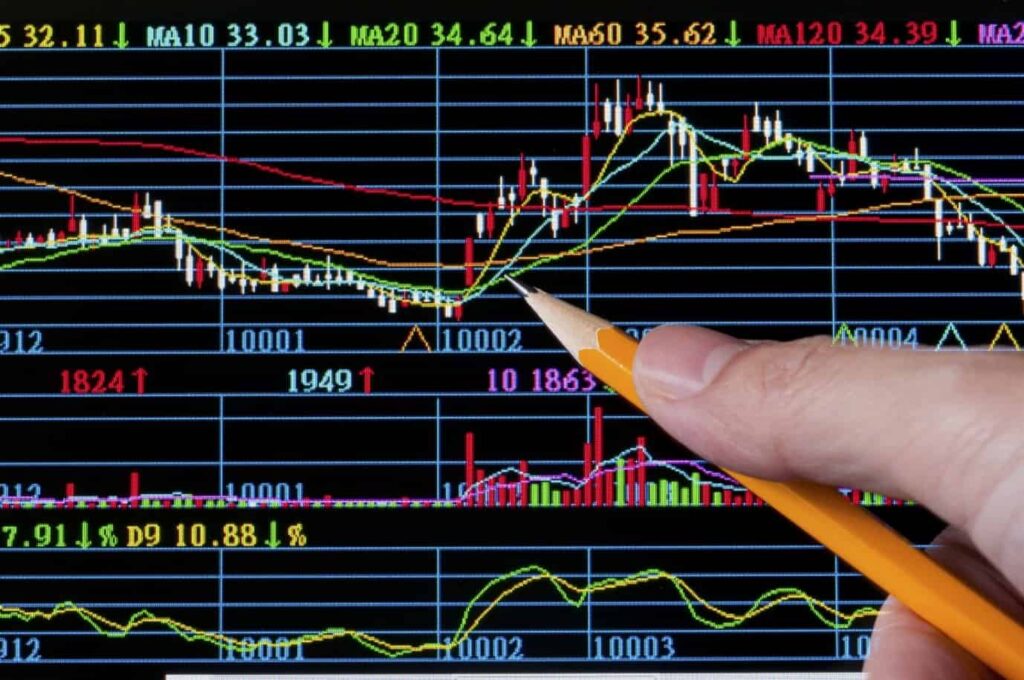
Introduction
The Simple Moving Average (SMA) indicator is one of the oldest and most common technical indicators used across all financial markets, including the forex market. It is essentially used to smooth out the effects of price volatility and create a clearer picture of changing price trends over time. Traders sometimes use an SMA alongside another SMA for a different period to confirm a change in the price behaviour of a particular asset.
Moving average strategies are popular with both long-term investors and short-term traders, as they can be easily tailored to any time frame. An SMA indicator can be set to monitor price trends over a period specified by the trader, whether 20 minutes, 100 days or 30 weeks.
In this article, we will look at how to use an SMA, how the indicator makes calculations and how the calculations look on a price chart. We will also examine how an SMA indicator can help a trader to identify trading opportunities and how to develop a simple SMA indicator trading strategy.
The first thing to know is that using an SMA stock indicator is relatively straightforward. The indicator has only two variables: period and price. The period can be set at any number, but values over 20 are advised when trying to identify longer-term trends. The price can be set at opening, closing, high, or low. The SMA indicator can also form a support or resistance line, depending on the type of trend identified that traders could incorporate into their decision-making process and trading strategy.
A simple moving average indicator can be very useful and provide any type of trader with important buy and sell signals. However, as with any technical indicator, there are disadvantages to using a simple moving average. As with many trading tools, the SMA is based on historical data to date. There is nothing predictive in the way calculations are made, so the system is far from infallible as a way of forecasting future price action.
In times of high volatility, when an instrument experiences many price changes over a short period, the price will swing back and forth, potentially generating multiple trade signals. When using the crossover strategy (outlined below), the moving average lines can become ‘tangled’ for a short period, again triggering multiple trading signals.
It is then vital that any trader using an SMA indicator understands how it works and recognises its limitations. A simple moving average strategy frequently relies on checking other trend indicators for confirmation and monitoring fundamentals that can impact the market in which you are trading.
How is the Simple moving average Indicator calculated?
An SMA indicator uses a calculation formula that simplifies pricing information by averaging it out over a specific period, which the trader specifies. The Simple Moving Average is calculated by adding the price of an instrument (for example, the opening price or the closing price) over a specified number of time periods and then dividing that sum by the number of periods. As the name implies, it is a way of simply finding the average price of an instrument over any set period.
An SMA indicator uses software programs to perform the necessary calculations. The simple moving average formula produces a gradually changing line imposed over the top of the price chart. As already mentioned, two separate simple moving averages can be used to compare the average price of an instrument over different periods.
You can choose any time period for a moving average, but typical lengths of time are 10, 20, 50, or 100. These periods can be based on any time frame that the chart you are using allows (so it could be a minute, a day, or a week, for example). Day traders will pick shorter time periods and long-term investors, longer ones. The time frame or length you choose is also referred to as the “look back period”.
Keep in mind that an SMA indicator set to monitor a short time frame will react much quicker to price changes than one with a more extended period set, so with shorter time frames, the SMA will more closely track the actual price than with longer time frames. Having said that, with very short periods, pricing information may be limited, potentially creating a false signal, so there are both pros and cons to using an SMA indicator for shorter or longer-term trading. The SMA is one specific form of trend indicator, but the concept also forms the basis for other technical indicators such as the moving average convergence divergence (MACD).
The SMA indicator is usually imposed over the existing candlestick formations on the chart. However, traders can also add the SMA to another indicator window, such as the RSI, to provide additional trading signals. The value of the SMA indicator is in its visual simplicity. Traders can quickly assess the prevailing trend of price behaviour from the direction of the SMA.
It must be remembered that the SMA is a lagging indicator, so it may not adjust rapidly to volatility in the market. This is also why the SMA is considered a good tool to use over more extended time periods. When shorter periods are chosen, there may not be enough pricing information to create a reliable result, which may increase the possibility of false signals.
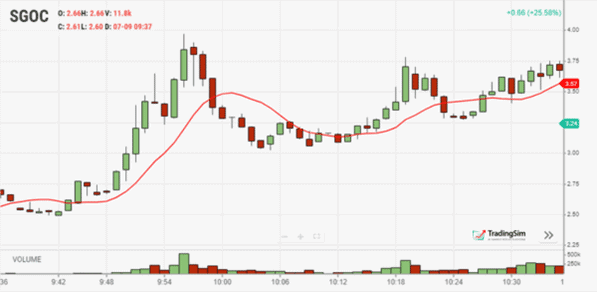
Image from Trading Sim
How to use the Simple moving average Indicator in forex trading
To use an SMA Indicator, you will need first to choose the setting for your variable. As already mentioned, there are only two: period and price. For period, you will choose a value, such as 30, and for the price setting, you could choose the opening price or closing price, or perhaps the high or low price, for each period. If you choose ‘30’ and ‘closing price’, the indicator will add up the sum of the closing price on each of the last 30 time periods and divide it by 30.
An SMA indicator is most useful when a strong trend is present over a long period. The key points of reference that traders pay attention to are when the SMA crosses over the pricing candlesticks. If prices are going up and a crossover occurs, that is viewed as a buy signal. If prices are decreasing and a crossover occurs, that is generally interpreted as a sell signal.
As with any technical indicator, an SMA chart will never be 100% accurate. False signals can occur, but the positive signals are consistent enough to give any forex trader an edge. Skill in interpreting and understanding SMA alerts can be developed over time, and complementing an SMA indicator with other technical indicators, such as a moving average convergence divergence (MACD), is a good idea. Using multiple technical indicators in tandem is always recommended, as the different ways of assessing trends will help further confirm potential price changes or cast doubt on potential trends.
Related Articles
A simple Sma trading strategy
There is no foolproof trading strategy when using an SMA indicator or any other trading tool. The strategy discussed here is for educational and demonstration purposes only. It is important to remember that this type of technical analysis uses previous price movements to attempt to forecast future price movements. However, past results are no guarantee of future performance. When it comes to trading forex, stocks or anything else, it is vital to consider that sudden changes or significant events in the real world can significantly impact the price of an instrument. It is advisable to combine technical analysis with fundamental analysis for the best chance of success.
Having said that, a simple trading system using an SMA indicator would involve:
- Determining your entry point at the crossover when prices move upward through the lagging SMA line
- Executing a “Buy” order for a predetermined amount that you have decided on using good trading discipline given your own circumstances – generally no more than 2% to 3% of your account.
- Placing a stop-loss order at 20 pips below your entry point
- Determining your exit point when the SMA crosses back through the pricing candles as they begin to reverse in a downward direction
Developing sound money management principles and discipline is vital to success in trading. Emotional trading and “spur of the moment” trading decisions are thought by many experienced traders to be why most retail traders lose money long term. As suggested above, having a predetermined entry and exit point, along with a stop-loss order, can be the key to success with any trading strategy.
Example Simple Moving average indicator strategy trades
There are a few different ways to use an SMA to make potentially profitable trades. The simplest is the one already mentioned: the price crossover strategy. You will simply use the price crossing above or below a moving average as a signal to buy or sell.
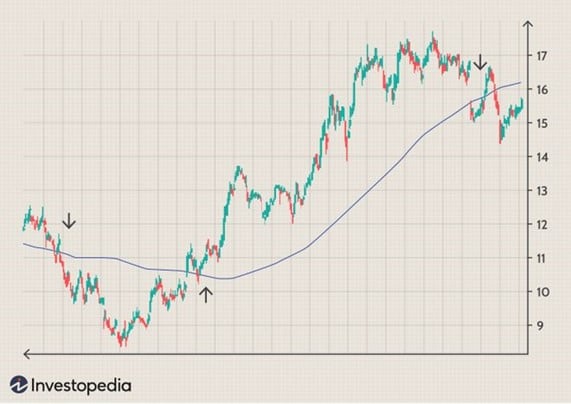
Image by Sabrina Jiang © Investopedia 2020
It is also possible to use a strategy where you apply two moving averages to a chart, with one based on a longer period and one on a shorter one. When the shorter-term moving average indicator line crosses above the longer-term moving average indicator line, this is a buy signal, as it suggests the trend is shifting up. This is sometimes known as a golden cross. The reverse, of course, is when the shorter-term moving average line crosses below the longer-term one. As you would expect, that is a sell signal, suggesting that the trend is shifting down. It is sometimes known as a death cross.
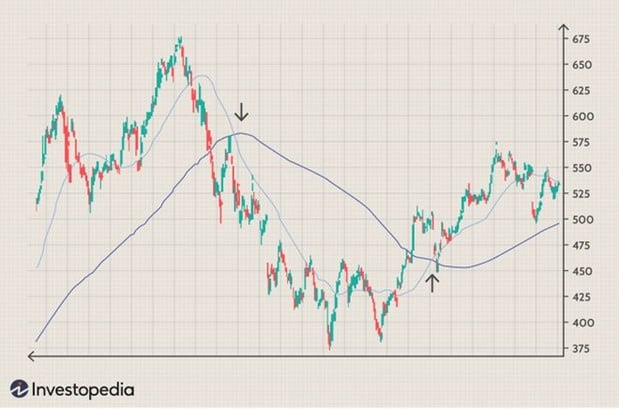
Image by Sabrina Jiang © Investopedia 2020
The Best Forex Demo Accounts
To master the SMA trading strategy you need to practice it. Reading the signals the charts and timing your entry and exit points correctly are skills that need to be mastered in order to maximise your profits. This is where a forex demo account comes in: It allows you to practice your new strategy without risking any of your hard-won capital. Below we have picked out some of our favourite forex demo accounts
| Broker | Features | Regulator | Platforms | Next Step | |
|---|---|---|---|---|---|
 Your capital is at risk
Founded: 2014 Your capital is at risk
Founded: 2014 |
|
FSPR | MT4 | ||
 Your capital is at risk
Founded: 2006 Your capital is at risk
Founded: 2006Europe* CFDs ar... |
|
ASIC, FSA, FSB, MiFID | MetaTrader4, Sirix, AvaOptions, AvaTrader, Mirror Trader | ||
 Between 74-89% of CFD traders lose
Founded: 2010 Between 74-89% of CFD traders lose
Founded: 2010Between 74-89 % of retail investor accounts lose money when trading CFDs |
|
ASIC, FCA | MetaTrader 4, MetaTrader 5, cTrader | ||
 Your capital is at risk
Founded: 2011 Your capital is at risk
Founded: 2011 |
|
CySEC, FSC, FSCA, MISA | MT4, MT5, OctaTrader | ||
 Your capital is at risk
Founded: 2009, 2015, 2017 Your capital is at risk
Founded: 2009, 2015, 2017 |
|
ASIC, CySEC, IFSC | MT4 Terminal, MT4 for Mac, Web Trader, iPhone/iPad Trader, Droid Trader, Mobile Trader, MT5 | ||
 Your capital is at risk
Founded: 2006 Your capital is at risk
Founded: 2006 |
|
CySEC, DFSA, FCA, FSB, SIA | MetaTrader4, MetaTrader5, cTrader, FxPro Edge (Beta) | ||
Conclusion
A simple moving average is a great way to simplify complex price data by smoothing it out and creating a single line, making it much easier to see an overall trend regarding price movements. A simple moving average reacts quickly to price changes, but there will always be a lag, which can have both advantages and disadvantages.
With a shorter timeframe, an SMA indicator will more closely reflect the actual price movements that are occurring, but this can result in false and potentially unprofitable buy and sell signals, especially during periods of high volatility. Over a longer period, the moving average line will not accurately reflect the actual price movements, but this can result in a clearer picture of long-term trends and far fewer false signals. An SMA indicator has both pros and cons, but is, in fact, highly versatile, which is why it is used by both long and short-term investors.
Using an SMA indicator requires determining in advance what your trading strategy will be, including determining precisely what your entry point and exit points will be, how much you will invest when a buy signal is triggered, and at what point you will place a stop-loss order, to ensure you do not lose too much money if you have indeed acted on a false signal. Using an SMA crossover as an entry and exit point is a popular strategy that works well for many traders. Remember that moving averages can also highlight areas of potential support or resistance.
Above all, remember that an SMA indicator is simply a helpful tool and is certainly not infallible. While it may appear predictive, an SMA is always based on historical data and simply shows the average price over a specific period. There are no guarantees of significant profits, even when using a solid SMA strategy. The most dedicated traders will tend to use an SMA indicator alongside other technical indicators and combine their technical analysis with some degree of fundamental analysis to avoid surprises and prepare for every eventuality.
Continue Learning
- More Forex Indicators Explained
- RSI Indicator Explained
- ATR Indicator Explained
- Momentum Indicator Explained
- Stochastics Indicator Explained
Forextraders' Broker of the Month
BlackBull Markets is a reliable and well-respected trading platform that provides its customers with high-quality access to a wide range of asset groups. The broker is headquartered in New Zealand which explains why it has flown under the radar for a few years but it is a great broker that is now building a global following. The BlackBull Markets site is intuitive and easy to use, making it an ideal choice for beginners.
